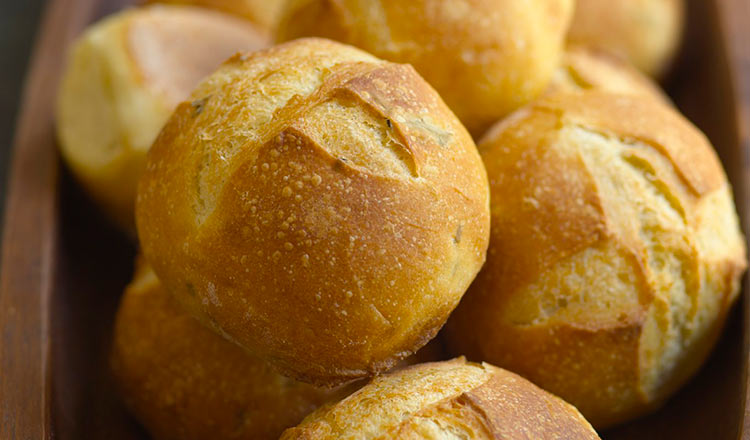Makes 22 rolls
Found in the pasta aisle of many supermarkets, durum flour—a wheat flour high in protein and gluten strength—contributes a slight yellowish hue to these aromatic rolls. The flavors of chopped rosemary and olive oil conjure up thoughts of the Mediterranean. Whether the dough is shaped into a loaf or baked as rolls (click here for the how-to), it’s an ideal accompaniment to a home-cooked dinner.
Ingredients
- 2 1/3 cups (18.5 ounces) water, 80 to 82°F
- 2 tablespoons (.8 oz) olive oil
- 1/8 teaspoon (.2 oz) malt syrup (see note)
- 3 1/4 cups (16 oz) durum flour
- 2 cups plus 3 tablespoons (10.5 oz) bread flour
- 1 tablespoon (.3 oz) yeast, instant dry
- 1 tablespoon (.6 oz) salt
- 2 tablespoons (.3 oz) rosemary, coarsely chopped
Directions
- Put the water, oil, and malt in the bowl of a mixer. Combine the flours and yeast and add to the bowl, then add the salt. Place the bowl on a mixer fitted with a dough hook, and mix on low speed for 4 minutes, making sure to scrape the bowl and flip the dough over once during mixing. Increase the speed to medium and mix another 2 minutes. Add the rosemary and mix for another minute on low speed, making sure to flip the dough over halfway through the mixing time. Place the dough in a lightly oiled bowl large enough for it to double in size and cover with plastic wrap.
- Allow the dough to rest in a warm place for 60 to 75 minutes, until, when lightly pressed, the dough springs back halfway.
- Place the dough on a lightly floured work surface, and stretch it out slightly. Fold the dough in thirds. Place the dough back into the bowl, re-cover it with plastic wrap, and let it rest for an additional 15 minutes.
- Prepare two baking sheets by lining them with parchment paper.
- Place the dough on a lightly floured work surface and divide into 22 equal pieces, about 2 ounces each. Shape into rounds.
- Place the rolls seam-side down on the prepared baking sheets. Cover the baking sheets loosely with plastic wrap. The rolls will be baked in two batches [sheets (A) and (B)].
- Place the first sheet (A) in a warm area and the other sheet (B) in the refrigerator. After 20 minutes, remove sheet (B) and place in a warm area. After an additional 20 to 30 minutes, remove the plastic wrap from sheet (A) and check to see if it’s ready to bake; the dough should spring back halfway when lightly touched.
- Thirty minutes before baking, preheat oven to 475°F. Ten minutes before baking, place a tray filled with 3 cups of warm water below the baking area in the oven to help produce steam.
- Prepare sheet (A) for baking. Spray or brush the rolls with water. Allow them to rest for 5 minutes, then spray or brush with water again. Score the tops with an “X” using a sharp razor blade held at a 90-degree angle to the top of the roll.
- Place sheet (A) in the oven and immediately reduce the temperature to 450°F. Bake for 10 minutes, then remove the steam tray and continue baking for an additional 8 to 10 minutes, until it forms a golden-brown, firm crust. Remove the rolls from the oven and place on a cooling rack.
- Raise the oven temperature back to 475°F, and preheat for 10 minutes. Reinsert the steam tray filled with 3 cups of warm water below the baking area in the oven; allow to steam for 10 minutes.
- Meanwhile, check sheet (B) to determine if it’s ready to bake; remove the plastic wrap and lightly touch the dough; it should spring back halfway when ready. Prepare sheet (B) for baking following the directions in step 9. Place the sheet in the oven and follow the directions listed in step 10.
Chef’s Note: Barley malt syrup, or malted barley, enhances the color and flavor of the rolls. It can be found at health food stores, specialty bakeshops, and online retailers. If you do not have access to malt syrup, you can make the rolls without it.


